Parallax is the effect where the position or direction of an object appears to differ when viewed from different positions. When an observer moves, the apparent relative motion of several stationary objects against a background gives hints about their relative distance which the brain can interpret to provide absolute depth information.
As you can imagine this can be very helpful to birds for flight and for judging prey position. The movement required comes automatically during flight but it can also be provided while perched by exaggerated movements of the head in all three dimensions. Tipping the head also provides cues by changing the relative position of the eyes to the object being viewed.
Learning to interpret this information takes practice so many juvenile birds do just that, owls in particular.
Techs for the following images – most were taken at 1/640 or 1/800, f/9, ISO 400, 500 f/4, 1.4 tc, natural light, not baited, set up or called in. All images presented in the order they were taken.
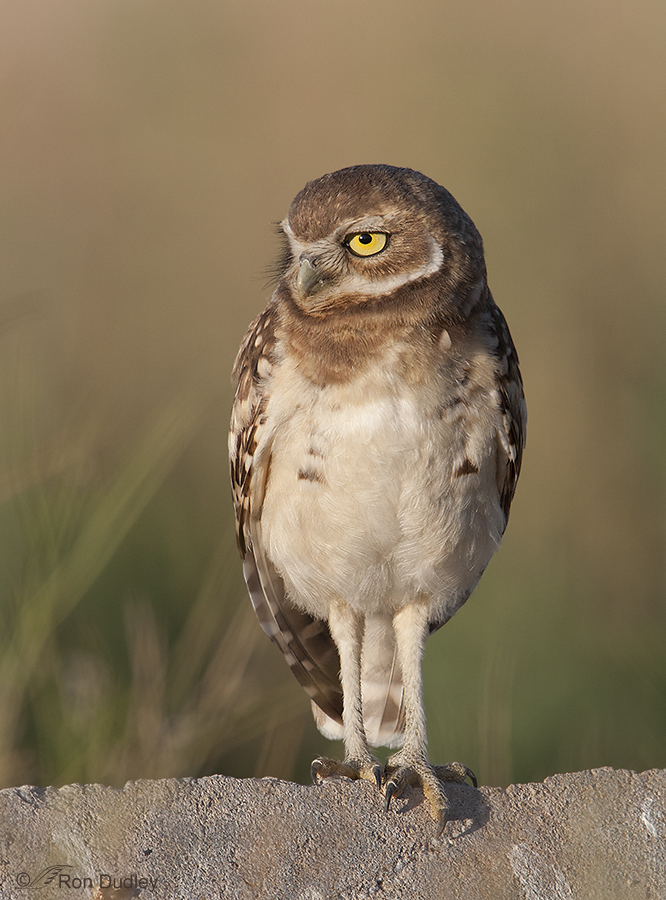
Several years ago I spent a lot of time over several weeks photographing a family of Burrowing Owls along the causeway to Antelope Island. Their burrow was very close to the road and they became almost completely acclimated to traffic so I was able to observe and photograph many interesting behaviors of both juveniles and adults from my pickup.
Here, this juvenile is simply ignoring me (for the sake of convenience I’ll refer to this bird as a male though I have no idea what sex it was).
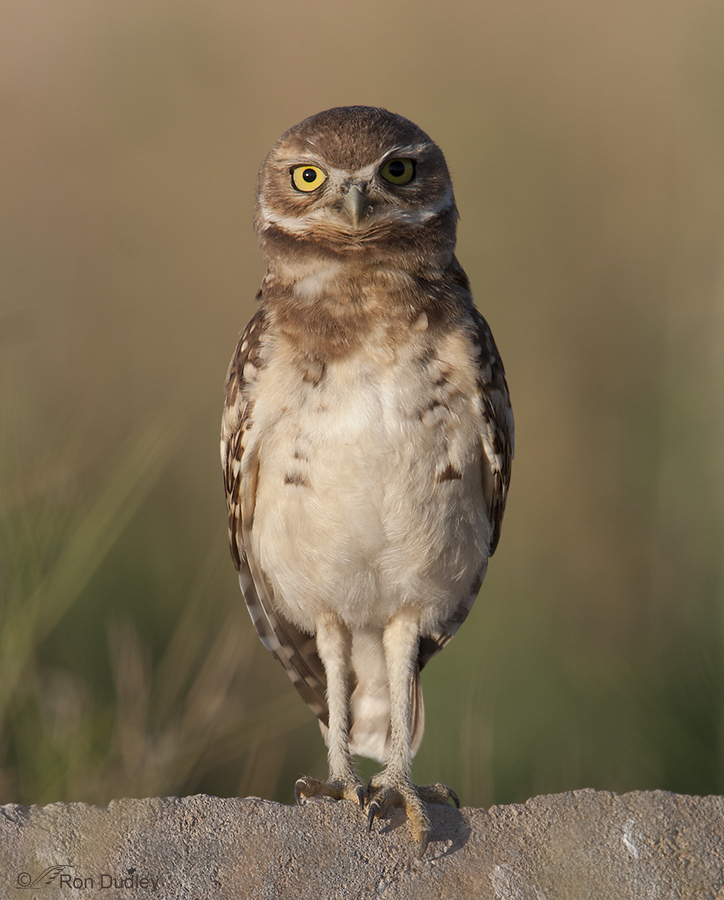
But a few seconds later he decided that the clicking sounds coming from my pickup sounded interesting and decided to investigate using parallax. He began by standing erect which moved his head to a higher position.
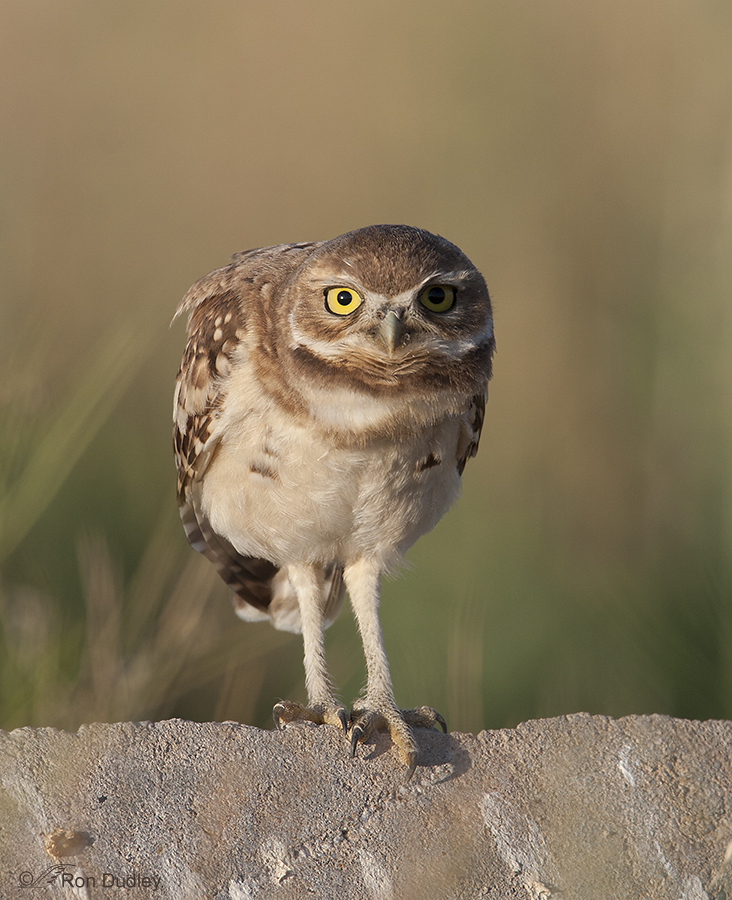
He then moved his head closer to me which provided additional visual depth cues to his brain.

Then he stood erect and started to tilt his head…
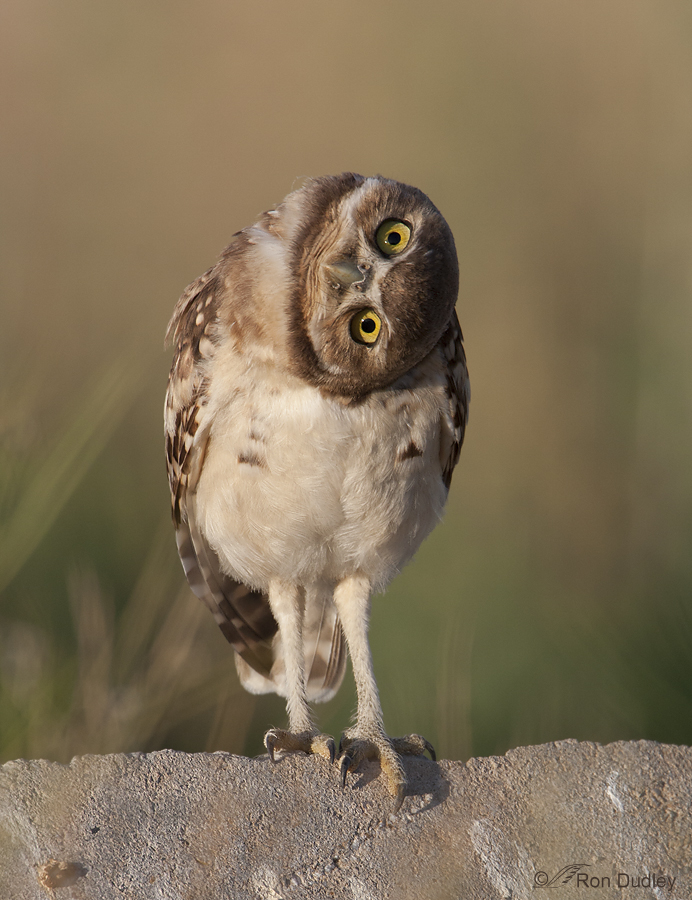
further…
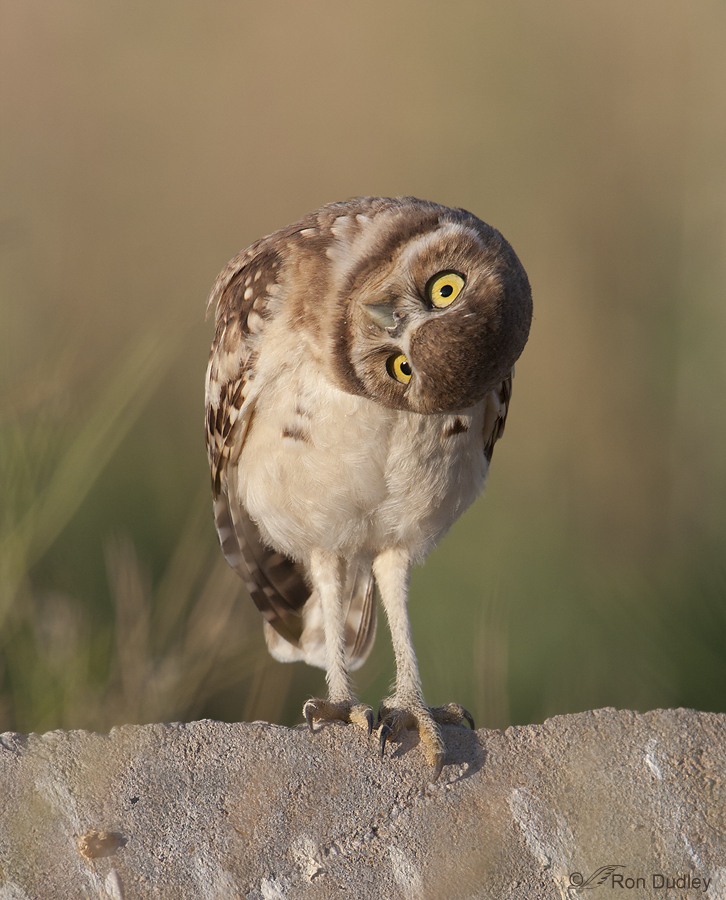
and further.
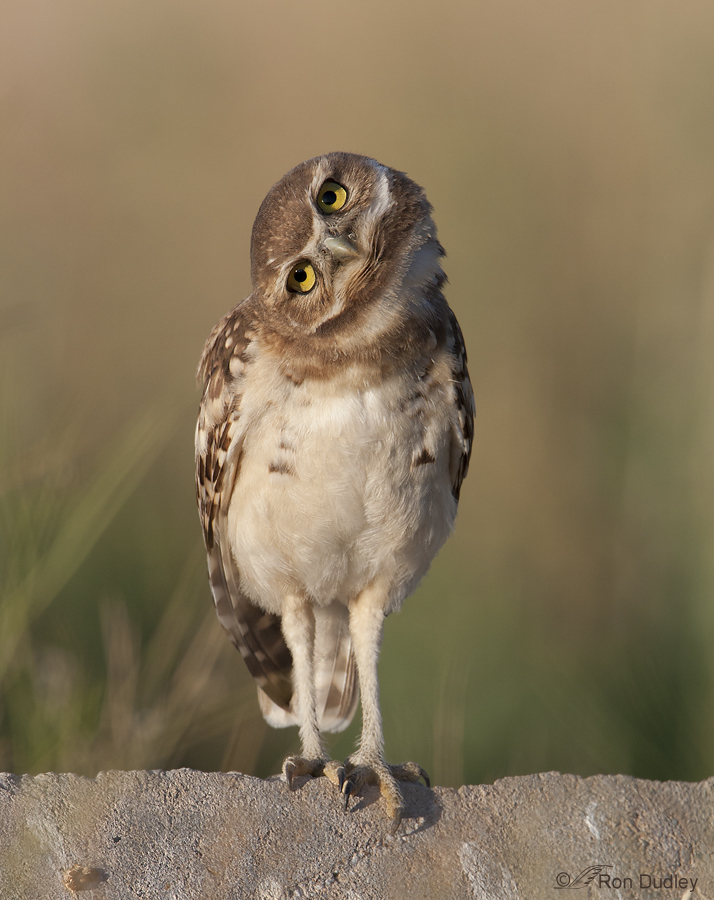
Then he began to tilt his head in the other direction…
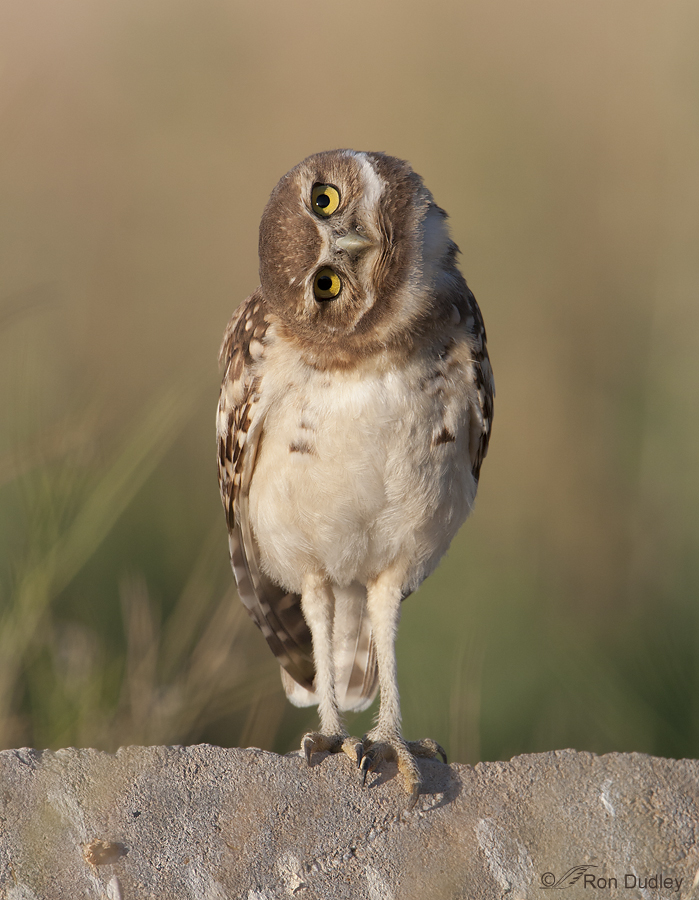
and went almost as far with it as he had previously.
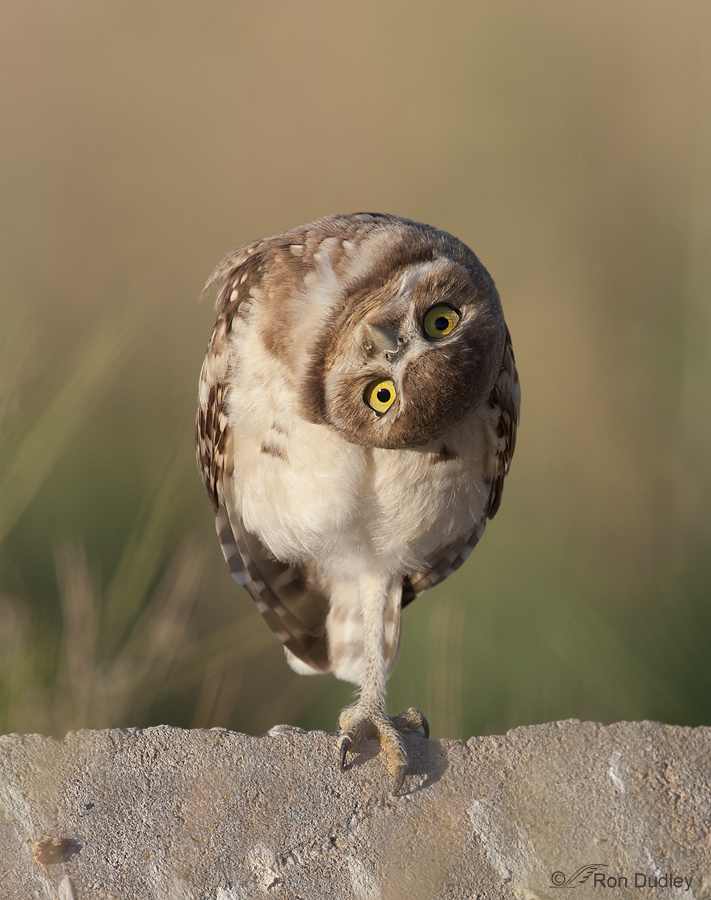
Then he went the other direction again and continued to alternate for some time. (I’ve posted this shot before and it also appears in my header images at the top of my blog).
I’ve seen parallax from a variety of birds but never such an extended session or from as close as this. It was cute as can be and endearing to watch.
Ron


Just wanted to let you know that I’m enjoying looking at all the photos you are posting. This series is by far my favorite.
Hi Ron,
Excellent photos. Your images and the associated discussion, especially that from Ken Britten (a close friend, great birder and major vision scientist), raise a number of issues of direct interest to me.
Depth perception is almost certainly mediated by several different neuronal circuits, using different strategies. There are different strategies for estimating distances. “True” stereopsis, as when picking up a small pin from the table, involves accurate correspondance between points on both retinas. In humans, our accuracy in 3D localization is directly related to the motor act with our hands. The accuracy of 3D/stereopsis declines with increasing distance. We still have some stereopsis (both eyes in register)at 20-30 feet, but we rely on many other cues.
For many years the claim was that nonmammals can’t have “true stereopsis” as they don’t have the neurological substrate for doing it. Most specifically, they were not known to have a partial crossing (hemi-decussation) of their retinal axons. The hemi-decussation provided a means of bringing the corresponding point of the visual world, as seen by each eye, to a common locus in the brain. The slight difference in angle to each eye produces the stereo effect, as realized by Wheatstone in the mid-19th century. This was the basis of the common and popular “Stereopticon” viewers.
In about 1969, we discovered that owls, pigeons and other birds, do have a hemi-decussation, but it happens one step (one synapse) later along the pathway. This work was done in burrowing owls and published in 1973. It was further explored by Pettigrew and Konishi in barn owls.
The related misconception pertains to eye movements in birds, and particularly in owls. Many birds have extensive eye movements, and the associated brain nuclei that control the eye. In order to bring the two eyes into correct correspondance even at slightly varying distances, the eyes must move in congruent mode and converge. Birds, and many other nonmammalian vertebrates, can thus switch from the mode where each eye can look at different parts of their visual world, to a mode where the two eyes move in a state of vergence. They do this move to vergence when concentrating on picking up an object in their near field of vision. In humans, this is generally about 18″. In a sparrow it is about 4″-6″. In Burrowing owls it is about 6″-9″ – or the distance to their toes. The claim that owl’s have no significant eye movements has not been checked with modern methods. Based on the organization of the neurons that move the eyes, owls do have the ability to move the eyes towards each other and downward (Trochlear nucleus).
As for the interesting suggestion about tilting the head as a means of sound localization, Barn owls have their auditory openings at different heights on the head. Burrowing owls do not have that asymmetry. Their brains also differ, reflecting the greater dependence on audition by barn owls compared to burrowing owls.
Sorry for the length of this post, but your photos are most interesting, and technically superb.
Would be glad to continue this conversation. I need photos of different species of birds, showing eye positions when they focus on near objects below their beak. Most pictures are taken from a lateral perspective.
regards,
Harvey Karten
Incredibly interesting stuff, Harvey. I’ve read it several times to get as much out of it as I possibly can, and I’ll do so again, I’m sure.
My understanding of eye physiology is rudimentary at best but I’m aware of the optiic chiasma, which I think you’re saying is where the “hemi-decussation” occurs that is required for steropsis. I had no idea that any birds have an optic nerve crossing like mammals do.
I find it fascinating that the neuron organization of owls suggests that they actually can move their eyes, despite what has been thought for so long. I guess I’m a little surprised that no modern research has been done on this since evidence now hints that their eyes can be moved in their head to some degree.
I’m aware of asymmetrical ear locations in owls but thought it applied to all owl species. I had no idea that Burrowing Owls were an exception.
I’ve observed juvenile Burrowing Owls up close “playing” with objects like small sticks and grasshoppers but I’ve always had a difficult time telling (when they were “reaching” to pick up an object with their beak) if they were actually focusing on it with one eye or two. For me, their forward eye placement made it difficult to to tell.
I have photos of passerines manipulating objects up close but usually they’ve had very dark or black eyes so I can’t accurately tell which direction they are actually looking. The first two shots in this post of a shrike impaling an insect would be an example:
https://featheredphotography.com/blog/2010/08/18/impaling-behavior-in-northern-shrikes/
Thanks very much, Harvey, for taking the time to share your considerable expertise with us. Very much appreciated!
Great pictures! Dave Sparks forwarded the link to me. Not only technically superb but really capture the behavior well. And the light is fantastic. I have a couple of thoughts on the behavior, which I have also observed in barn owls. The vertical head-bobbing seen in so many animals is almost certainly “parallaxing” – using parallax, and especially motion parallax, to estimate distance. But the head rotation seems unlikely to be serving this purpose, since that would mean that the owl would be keeping two independent, monocular representations intact and performing the parallax computation on each one. While anatomically possible, this seems unlikely to me. There are two other possibilities which seem more likely. One is that the owl is getting stereo vision from different features in the image. Since “normal” stereo vision rests on the horizontal disparity of image features, it is best informed by vertical contours in the image. A horizontal feature is useless. By rotating its head, the owl might be getting depth for these features. One thing that might help to see if that was going on was to know how far you were from the bird. Stereo vision only works for fairly near objects. For the owl (and I am guessing here), probably out to about 15-20 feet or so. But I actually like another completely different idea the best. No surprise that we humans – and especially all the photography fans on this site – are biased towards a visual explanation. But it could has to do with hearing instead. Owls are superb at sound localization, and horizontal acuity is better than vertical. I am guessing that by turning its head sideways, it is using its hearing to better define your vertical position. Naturally, none of these ideas are exclusive of each others – the owl might be doing all of this at once. Clever bird!
Ken, I was roughly 25′ from the bird but I’m guessing that your last idea is what this bird was really doing with the head rotation (though it was parallaxing with the head bobbing, as you say). I’m surprised that I didn’t even consider the possibility that the owl was cueing in on sound rather than light. There were two cameras making shutter noises when this behavior occurred and I’m really thinking that you’re most likely right – the bird was “investigating” those interesting noises coming from my pickup.
Thank you very much for adding to this discussion, Ken. What you had to say was extremely helpful!
Delightful set of photos on the little owl!
Thank you, Howard.
Amazing series …. brought a smile to my face.
I find it more amazing that he/she can do all that gyrating and end up on one leg! I would’ve fallen over a few shots back!
You noticed that too, Chris. I liked it because it indicated how comfortable the owl was with me so close.
Animals use motion parallax, in which the animals (or just the head) move to gain different viewpoints. Owls are known for their extremely large eyes in comparison to their skull. The eyes of the owls are tubular in shape. Since the eyes are fixed into these tubes, they are unable to move the eyes in any direction. Instead of moving their eyes, owls swivel their head to visualize their surroundings. They can see what’s behind them without moving the torso. Owls also have only one occipital articulation with the cervical vertebrae. (There is only one bone situated on top of the backbone.) Humans have two articulations. This allows the owl to pivot on the vertebrae column. The owls’ neck bones, or vertebrae, contain holes that are much larger than those found in other birds or humans. This gives their blood vessels some slack when the bird twists its head so they can oxygenate their brain. You can upload this beautiful diagram of the anatomy of the owl’s vertebra and circulatory system in the link I’m about to give you. It’s a JPEG file for viewing only: https://nsf-scivis.skild.com/skild2/nsf2012/viewEntryDetail.action?pid=40747 You have to press “view Image”. It’s really about the owl’s circulatory system but it’s a beautiful, very detailed illustration.
That’s a fascinating set of diagrams, Maria. Thank you for the link.
AWESOME PHOTOS!!!!!
Thanks, Nicole.
So wonderful, Ron! This series touches my heart. Thank you!
They have a similar effect on me, Sharon. It was an even stronger feeling when I was watching it happen in person.
From the reading your article motivated me to do, it seems your owl was, indeed, using parallax to attempt to pinpoint your location. Since the eyes of the owl are fixed in their skulls, they really have to continue to rotate their head to locate their prey. At the same time, since they use sound in conjunction with sight (except in total darkness), the head-turning allows their facial disks to home in on any sound being emitted (squeak of a vole or clicking of a camera shutter).
I have no expertise in this area at all, but it sure is interesting to learn more about this extraordinary owl.
I’m more inclined to go with Julia’s observations about the whole thing, “so cute” and worthy of sharing with the nearest child!
Thanks, Wally. Sounds like this post prompted you to do a little research – a good thing, seems to me.
So interesting! I love your blog Ron…thanks for the content rich teaching moments as well as the stunning pictures!
I’m glad you enjoy the “teaching moments”.
So fun to see!
Thanks, Teri.
What a beautiful, delightful, and informative sequence of photos! I first taught about STELLAR parallax in an astronomy class long ago. Who would have thought that, over 40 years later, I would be learn about BIRD parallaxing. Cool.
Thanks, Dwynn. Your comment brought back memories. I was first introduced to stellar parallax 45 years ago as a sophomore in an astronomy class at Palomar College, CA (named after the observatory and the mountain which were nearby).
Hi Ron,
I enjoy your photography very much. I enjoy your owl shots, as I don’t find many owls in my usual spots.
I believe the owl in this situation is doing more than using parallax. I recently finished the book “Bird Sense: What It’s like to be a Bird”, by Tim Birkhead.
http://www.amazon.com/Bird-Sense-What-Like-ebook/dp/B007DD8GRQ/ref=dp_kinw_strp_1/186-3324372-2090416
He goes into the anatomy of a birds eye in some detail. Birds, like humans have, have a region of greatest density of receptors, called the fovea, which is the area of greatest forward visual acuity. However, many birds, including most birds of prey have a second fovea for enhanced sideways viewing.
From Wikipedia:
Behavioural studies show that many avian species focus on distant objects preferentially with their lateral and monocular field of vision, and birds will orientate themselves sideways to maximise visual resolution. For a pigeon, resolution is twice as good with sideways monocular vision than forward binocular vision, whereas for humans the converse is true.
http://en.wikipedia.org/wiki/Bird_vision
Is it possible it’s turning it’s head to use the part of its eye that gives it a sharper view of you?
I suppose it’s possible, John. I’m certainly no expert on the subject.
But if it were turning it’s head to make light from me fall on the fovea it seems to me that only one head position (or possibly two, one for each eye) would accomplish that. This bird was gyrating its head through many different positions in space in three dimensions so that makes me believe that parallax is primarily what was going on.
If anyone else has some informed thoughts on this I’d love to hear them. (Dave Sparks, perhaps?)
So cute!!!! This really had me laughing out loud with my son this morning! Thank you for sharing. The images you capture are so amazing!
Thank you, Julia. I’m delighted to hear that your son enjoyed these photos too.